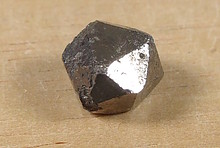Ringwoodite - the true story
Last Updated: 17th Feb 2015By Bill Cordua
Note: This first appeared in the Midwest Federation Newsletter, May, 2014
Recent headlines about the first finding of the rare mineral ringwoodite in earth rocks contained references to “vast oceans” and “sunless subterranean seas” revealed by a “water-rich gem” in a “satanic hell diamond”. Lurid stuff, and very misleading. It is an exciting find to geologists, but to understand why, we need to back away from the inaccurate hype and do a little basic geology.
First, what is ringwoodite? It is a polymorph of the more familiar mineral olivine. The gem variety of olivine is peridot, so that’s the gem link. Both olivine and ringwoodite have the same chemicals in them – (Mg,Fe2+)2(SiO4). The atoms in them are arranged internally differnetly, making them officially different minerals. Ringwoodite was first synthesized in the lab, and was thought to form at great depths in the earth where, hypothetically, temperature and pressures would allow it, and not olivine, to form. It was first found naturally in meteorites that were from the interiors of smashed up asteroids that fortuitously found their way to earth. It was named for a famous Australian geologist known for his studies of the earth’s mantle. Synthesized ringwoodite is pretty. It can be deep blue, red or other colors depending in what impurities are there. If found in large enough pieces there is no doubt it would be gemmy. The pieces found in meteorites are microscopic, so their use as a gem is limited unless you like really tiny pieces of jewelry. And it wouldn’t be accurate to call it “peridot” because it isn’t olivine. This provides an opportunity for some one to create a really glitzy name for the gem ringwoodite.
This recent find of the first terrestrial ringwoodite was announced in the March 14, 2014 issue of the journal Nature. The mineral occurs as a small (60 micrometer) impurity in a diamond brought up in a Brazilian kimberlite pipe. Diamonds form in the earth’s mantle and are carried up as “passengers” by magmas that come from deep in the earth. These magmas are the geologists’ cheapest “deep earth probes” – they bring up samples of rocks from depths far below any we’ve ever drilled to. Such rocks are great windows into what things are like down there, so are good places to look for minerals like ringwoodite.
Since diamonds are pure carbon, and ringwoodite is (Mg,Fe2+)2(SiO4), a key question is: where’s the water? It turns out that ringwoodite’s structure is open enough to include loosely bonded OH1- and H1+ ions as impurities. If you shake the mineral, water does not come out. If you heat it or push it closer to the surface, it may partly melt to produce a magma that has a bit of water in it. In other words, the raw ingredients that can be made into water exist down there as molecules scattered at the atomic scale in the structure of ringwoodite and other minerals (such as another olivine polymorph called waddsleyite - don’t ask). Estimates are that these “water” ingredients may make up about 1 weight percent of the rocks.
Okay, where is this “sunless subterranean sea”? Ringwoodite should be pretty common in parts of the mantle, particularly between 520 and 660 kilometers down in an interesting region called “the transition zone”. This is a lot of area. Even if ringwoodite is not particularly common, there is potentially a lot of water if it could all be extracted from it and put in one place. In fact, such a volume of water could exceed what we have at the surface. But, remember, this “water” is locked up as ions in billions of tiny mineral grains. So no big open cavities with sloshing seas and plesiosaurs, a la Jules Verne. Sorry.
Why is this find so important to geologists? The mantle is poorly known, but is crucial in understanding earth processes. The minerals occurring at different depths give insight into all kinds of deep earth phenomena such as “hot spot” magma generation, convection, plate movement and earthquakes. The presence of even 1% “hydrous” materials affect significantly how these rocks melt and otherwise behave, so geologists now have a firmer understanding of how to model these processes for our planet. Also our surface oceans are proposed to have come from magmas “degassing” from inside the earth, perhaps 4 billion years or so ago. It’s unlikely this process was 100% efficient, so it’s good to be able to support this theory by confirming that the materials that could have made this happen are still there, deep down.
Finally I think those folks who think deep earth minerals are “satanic” ought to get rid of all that nasty diamond jewelry before it does them harm. I personally volunteer to take the Hope Diamond off the Smithsonian’s hands.
Dr. Bill Cordua
Emeritus professor of geology, U. of Wisconsin – River Falls
Recent headlines about the first finding of the rare mineral ringwoodite in earth rocks contained references to “vast oceans” and “sunless subterranean seas” revealed by a “water-rich gem” in a “satanic hell diamond”. Lurid stuff, and very misleading. It is an exciting find to geologists, but to understand why, we need to back away from the inaccurate hype and do a little basic geology.
First, what is ringwoodite? It is a polymorph of the more familiar mineral olivine. The gem variety of olivine is peridot, so that’s the gem link. Both olivine and ringwoodite have the same chemicals in them – (Mg,Fe2+)2(SiO4). The atoms in them are arranged internally differnetly, making them officially different minerals. Ringwoodite was first synthesized in the lab, and was thought to form at great depths in the earth where, hypothetically, temperature and pressures would allow it, and not olivine, to form. It was first found naturally in meteorites that were from the interiors of smashed up asteroids that fortuitously found their way to earth. It was named for a famous Australian geologist known for his studies of the earth’s mantle. Synthesized ringwoodite is pretty. It can be deep blue, red or other colors depending in what impurities are there. If found in large enough pieces there is no doubt it would be gemmy. The pieces found in meteorites are microscopic, so their use as a gem is limited unless you like really tiny pieces of jewelry. And it wouldn’t be accurate to call it “peridot” because it isn’t olivine. This provides an opportunity for some one to create a really glitzy name for the gem ringwoodite.
This recent find of the first terrestrial ringwoodite was announced in the March 14, 2014 issue of the journal Nature. The mineral occurs as a small (60 micrometer) impurity in a diamond brought up in a Brazilian kimberlite pipe. Diamonds form in the earth’s mantle and are carried up as “passengers” by magmas that come from deep in the earth. These magmas are the geologists’ cheapest “deep earth probes” – they bring up samples of rocks from depths far below any we’ve ever drilled to. Such rocks are great windows into what things are like down there, so are good places to look for minerals like ringwoodite.
Since diamonds are pure carbon, and ringwoodite is (Mg,Fe2+)2(SiO4), a key question is: where’s the water? It turns out that ringwoodite’s structure is open enough to include loosely bonded OH1- and H1+ ions as impurities. If you shake the mineral, water does not come out. If you heat it or push it closer to the surface, it may partly melt to produce a magma that has a bit of water in it. In other words, the raw ingredients that can be made into water exist down there as molecules scattered at the atomic scale in the structure of ringwoodite and other minerals (such as another olivine polymorph called waddsleyite - don’t ask). Estimates are that these “water” ingredients may make up about 1 weight percent of the rocks.
Okay, where is this “sunless subterranean sea”? Ringwoodite should be pretty common in parts of the mantle, particularly between 520 and 660 kilometers down in an interesting region called “the transition zone”. This is a lot of area. Even if ringwoodite is not particularly common, there is potentially a lot of water if it could all be extracted from it and put in one place. In fact, such a volume of water could exceed what we have at the surface. But, remember, this “water” is locked up as ions in billions of tiny mineral grains. So no big open cavities with sloshing seas and plesiosaurs, a la Jules Verne. Sorry.
Why is this find so important to geologists? The mantle is poorly known, but is crucial in understanding earth processes. The minerals occurring at different depths give insight into all kinds of deep earth phenomena such as “hot spot” magma generation, convection, plate movement and earthquakes. The presence of even 1% “hydrous” materials affect significantly how these rocks melt and otherwise behave, so geologists now have a firmer understanding of how to model these processes for our planet. Also our surface oceans are proposed to have come from magmas “degassing” from inside the earth, perhaps 4 billion years or so ago. It’s unlikely this process was 100% efficient, so it’s good to be able to support this theory by confirming that the materials that could have made this happen are still there, deep down.
Finally I think those folks who think deep earth minerals are “satanic” ought to get rid of all that nasty diamond jewelry before it does them harm. I personally volunteer to take the Hope Diamond off the Smithsonian’s hands.
Dr. Bill Cordua
Emeritus professor of geology, U. of Wisconsin – River Falls
Article has been viewed at least 8078 times.















